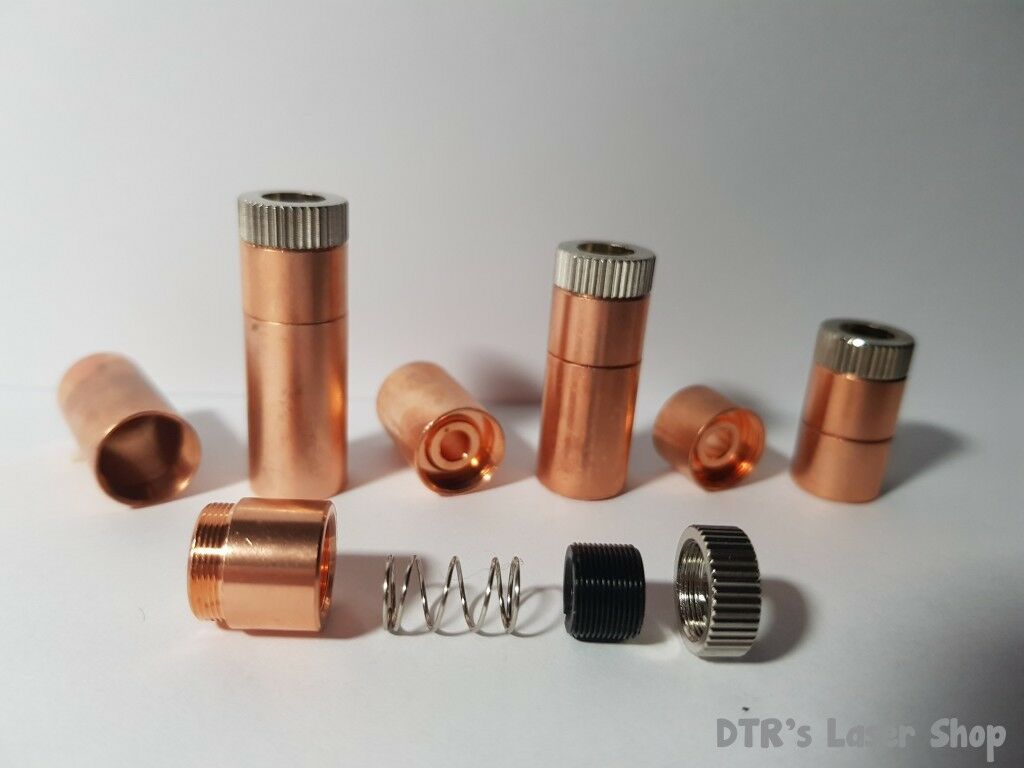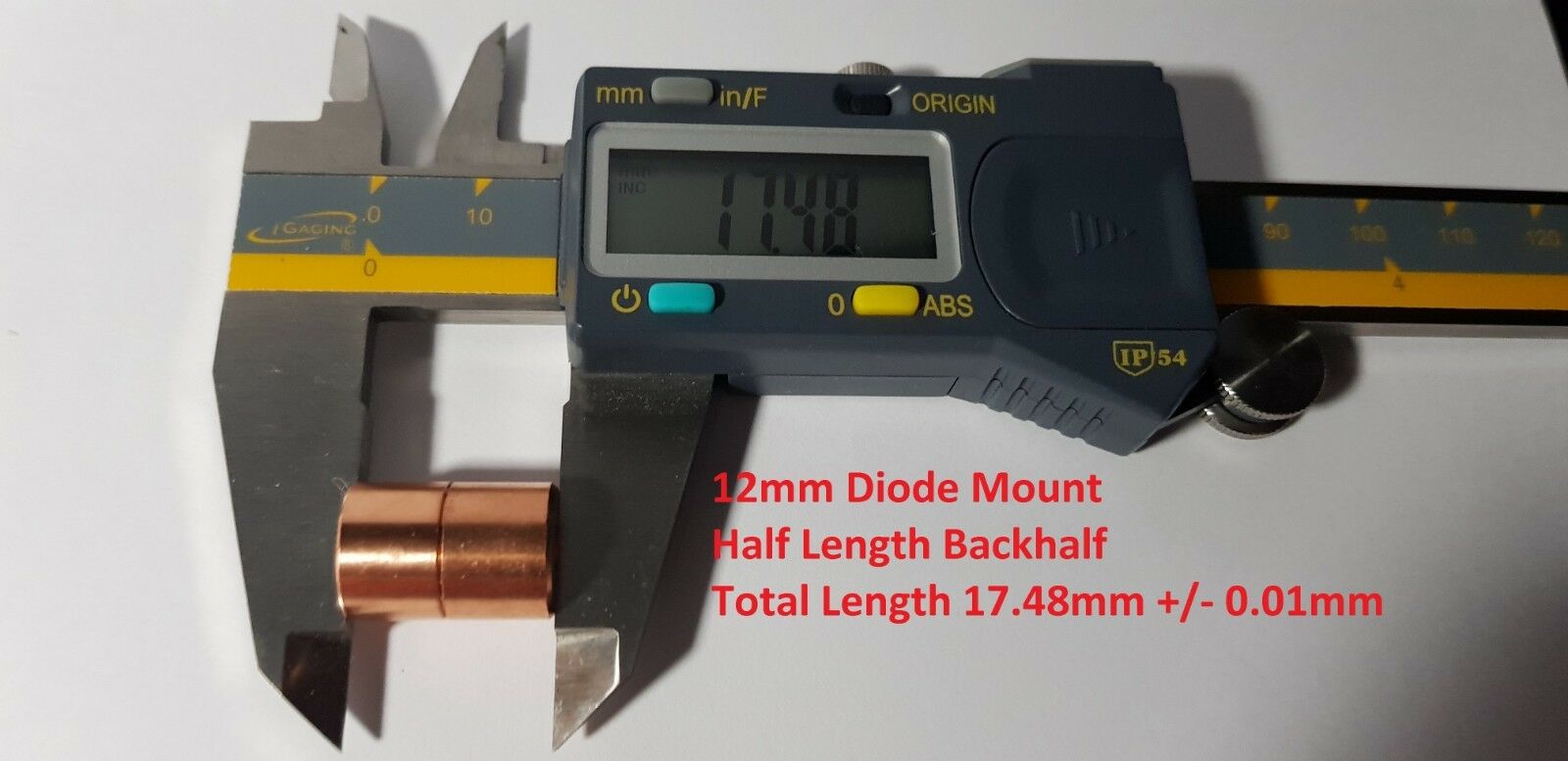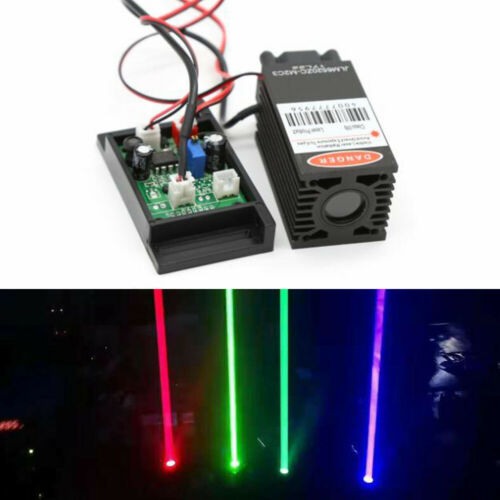-40%
12mm Copper Laser Diode Mount Blank Modules - 3.8mm - 5.6mm - 9mm - DTR-CLMV5-12
$ 9.5
- Description
- Size Guide
Description
12mm DTR Copper Laser Modules V5 for 3.8mm, 5.6mm and 9mm laser diodes.DTR-CLMV5-12
12mm laser modules are a common standard for laser DIY and countess end products like CNC, lightshow, 3d printers, ect... that incorporate diode based lasers as a component of the system. It makes a quick straightforward way to install and remove for service by using a receiver mount that for the module that also serves as a heastink with some with angle adjustment for cusom alignment before locking it in place.
The standard for 12mm laser modules calls for a 0.05mm under size @ 11.95mm paired with a heatsink milled with a boar of
12.00mm and both module and heatsink heed to have at least a +/-0.01mm tolerance for a proper perfect fit if it uses a set screw to secure the module. Greater than a 0.07mm difference will have thermal contact issues with the set screw types and less than 0.03mm will be an
interference
fit require pressing in which makes it very hard to remove if service or change out is required.
A clamp style is the best option for proper thermal contact all the way around the module like the Z-Bolt heatsinks for 12mm laser modules or a SK-12
aluminum
rail mount.
These modules are precision machined to meet the 12mm common standard with a
12mm(11.95mm)X30mm and
a +/-0.01mm tolerance out fine copper C1100 which is the highest grade of copper at 99.9% pure. These modules were originally designed as a cooperative effort by a forum community to deal with tolerance issues with clones of the older Axiz designed 12mm plated brass modules being widely sold at the time. These units large variation in tolerances for the outer diameter as extreme as 11.80mm to 12.10mm causing issues using heatsinks using the standard 12.00mm boar where the to be in proper spec the module is undersized by 0.05mm as less would be an interference fit requiring pressing the module in. If the module is too small there will be poor thermal contact which can cause the laser to overheat and die or run hot and degrade at an accelerated rate. Also brass was just not efficient enough for higher power diodes that were starting to become available. They bottle necked and just could not dissipate heat to the sink as fast as it is created. Thermal transfer is very important and having high quality copper and good tolerances is very important to the proper operation of high power laser didoes.
Note on new clones of these modules being offered usually refereed to as "Red Copper"
In China brass commonly is commonly
refereed
to as
copper unless specified noting a grade of actual copper and the term "Red Copper" is now being used to note that it is copper and not brass which
is a mix of copper and zinc usually around a 60/40 split.
There are also a lot of low grade coppers being used do to the skyrocketing cost of pure copper. Low grade copper with a lot of impurities or brass removes the thermal transfer
efficiency
advantage of
using
pure C1100 grade copper.
When you see "Red Copper which is 3 time faster on heat dispensation than normal copper" it is comparing the thermal
efficiency
of copper to brass and the rate is about right if assuming a pure grade copper like C1100.
High grade copper with low impurities is getting very expensive and it is not uncommon to see low grade coppers being used to lower costs but using low grade copper for this application can cause
degradation
or COD damage if not able to transfer the heat
away
from the diode as quick as it is being generated with some of the newer
generation
high power laser diodes that produce a massive amount of waste heat
. Search for some of the
reviews
over on the forums for more details. Low grade copper can have even lower thermal transfer
efficiency
than brass but will have the red color. you can usually spot it pretty easy as it may have a slightly pitted surface, it is more brittle than
pliable
and threading can be rough with lots of burrs which is another danger of particles breaking off and getting on the
diode
window burning up the laser.
Warning if you buy a heatsink that is
over sized
due to poor
machining
which the low quality cheap ones that are all over ebay thow it out. Don't attempt to fill
physical gaps
with thermal grease as that is not going to work and your diode will
degrade
from overheating in the now thermally isolated module that only has a sliver of direct with a heatsink. Thermal compound is for filling
microscopic
gaps between two
surfaces
in direct contact with pressure. It will actually work against you.
Also the acrylic lenses should only be used with diodes with power output of 300mW or less. Use with higher power diodes will melt the lens and very likely ruin the diode. A glass lens is needed for higher power diodes.
New variations are now available as well as full copper in all back half options. There also options with glass lenses and the full and half length back halfs are a must if using diodes with powers of 4W and above as they draw heat directly from the base but that means no options for internal laser drivers as can be done with the hollow back halfs.
A diode press is available as well and if chosen will come with the press for the type of diodes the models orders fit and a sleeve that acts as a centering guide for pressing diodes into the diode mount.


















